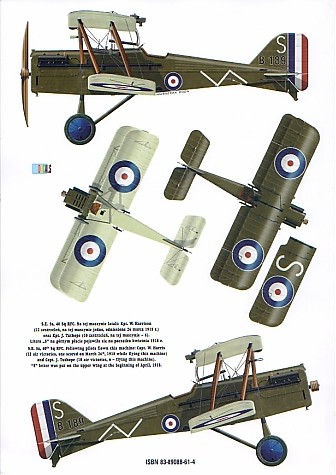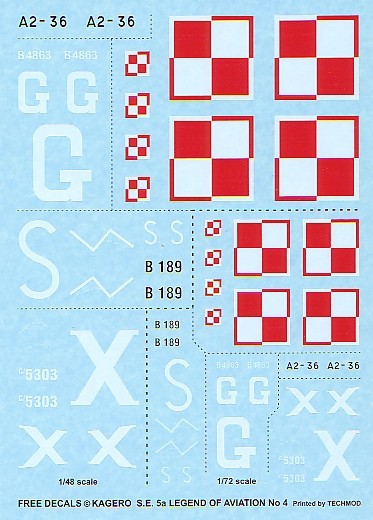Reviewed by
Rob Baumgartner

Kagero's SE5a
book is available online from Squadron.com
Number four in Kagero’s “Legends of Aviation” series focuses
on the SE5/5a.
With a total of eighty-four pages, the
book is presented in the familiar A4 soft cover format. There are eighty black
and white photographs and the layout sees these printed to a commendable size.
 Despite
this, the images are not as clear as one would expect and many have been
reproduced to a better standard elsewhere.
Despite
this, the images are not as clear as one would expect and many have been
reproduced to a better standard elsewhere.
The selection of some of these can also
be considered strange. An image showing pilots of 68 squadron during their DH5
days is certainly out of place. The inclusion of the infamous “aerial dogfight”
series must also be questioned. The captioning of these fakes merely stating “a
fierce dogfight against Albatros D.V.’s” amongst other one liners.
The book is very comprehensive though
and shows the author has gone to a lot of trouble to make it as complete as
possible. It all starts with a combat taken from “Sagittarius Rising” by Cecil
Lewis. From there the author discusses the origins of the British Air Force
before talking about the evolution of the SE5.
The reader is lead through the various
issues relating to the engines, prototypes, manufacturing and production runs.
The latter is covered with an explanation of the changes made as well as a
breakdown of the licensing to each company involved. A list is also supplied
matching serial number blocks to manufacturers.
There is a chapter on the general
description of the aircraft before a dive into the combat use by the different
squadrons. This gives a brief description of the unit, and some of the more
common Aces that flew the type. Other than the British squadrons, users from
additional countries are also mentioned.
A section on painting and markings leads
into sixteen pages of General Arrangement and detail views. The majority of
these are in 1/48th scale with the occasional close-up being in the
larger 1/24th. These are very detailed and cover the SE5, SE5a and
the numerous variations thereof. A bonus is seeing the full underside of the top
wing, a feature most publications leave out.
The majority of the interior drawings
are in colour and help the reader ascertain exactly where the internal
components are located. It’s a pity that none of the items are labelled though.
The author’s enthusiasm for the aircraft
is evident in the writing, and occasionally leads to the inevitable piece of
bias. For example, he uses the shooting down of Werner Voss as an example of the
SE5a’s qualities. What he fails to mention is that in the dogfight the odds were
6:1 against him and in the words of one of those present, “(Voss) could have
disengaged himself from the combat at any time”.
There is the odd “hiccup” contained in
the text, the most obvious being on page 9: “In 1916 the then best fighter
aircraft with the RFC – the Sopwith Camel – proved worse than Fokkers and
Albatroses in terms of performance and armament”. Hmmmm.
The translation from Polish to English
is very good with little interruption in the flow of the sentences.
 Fifteen
colour profiles are displayed with five of them appearing on a decal sheet. This
sheet is beautifully printed and has markings for both 1/48 and 1/72 scales. All
items were in perfect register on the very thin carrier film.
Fifteen
colour profiles are displayed with five of them appearing on a decal sheet. This
sheet is beautifully printed and has markings for both 1/48 and 1/72 scales. All
items were in perfect register on the very thin carrier film.
The book lists the decal options as:
-
SE5a rebuilt in Australia
as a two seater, Point Cook 1930.
-
SE5a flown by Capt. S.
Ciecierski
-
SE5a, c/5303 of 56
Squadron.
-
SE5a, B4863, of 56
Squadron, flown by Captain J T B McCudden.
-
SE5a, B 189, of 40
Squadron, flown by Captain J Tudhope.
A couple of comments are necessary
concerning schemes 4 and 5.
If you plan on doing McCudden’s
aircraft, there are published photos that show no white outer ring on the top
wing roundels.
Regarding Tudhope’s machine, the
eagle-eyed viewer will notice the different interpretation of the lower ring
roundel position on the profile compared to the cover painting. The profile also
portrays asymmetrical upper wing roundel positions.
A clear photo of B 189 indicates the
roundels are much further outboard than the profile indicates.
Photographs of 40 squadron SE5a aircraft
taken after late March 1918 reveal the new “N” flash unit marking that was
applied to the fuselage sides. Quality prints of the aircraft in scheme 5
clearly show the three over painted white bands that were the old unit markings.
Also covered up but still discernable was the fuselage “S”.
The upper wing “S” should be on the port
side, not on the starboard as depicted.
Also missing is the white chevron on the
tailplane, a marking seen on some other 40-squadron SE5a aircraft.
This is a very interesting book and one
that has a lot of information to absorb.
There is a mass of plans for the
enthusiast to digest and these will keep the devotee busy for quite a while.
Meanwhile the modeller can enjoy the
first class decals and use these to create another masterpiece from the latest
SE 5a offerings.
Recommended
Thanks to Squadron for the review sample.
Review Copyright © 2005 by
Robert Baumgartner
Page Created 31 May, 2005
Last updated 31 May, 2005
Back to HyperScale
Main Page
Back to Reviews
Page
Home | What's
New | Features
| Gallery |
Reviews | Reference
| Forum
| Search